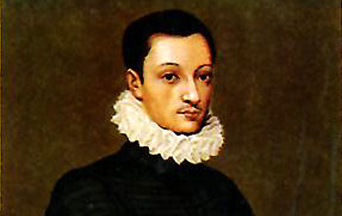
Aloysius was born in March 1568 into one of the most illustrious families in Christendom—his father (the Marquis of Castiglione) and his mother had served at the court of Philip II of Spain; a cousin was the Duke of Mantua; and a Gonzaga often sat in the College of Cardinals (three in the sixteenth century). When the boy was about four, his father, Don Ferrante was given command of 3,000 Milanese soldiers destined to protect Philip II’s North African possessions from the Ottoman pirates. Aloysius accompanied him to the training camp. The young prince (all male Gonzagas were princes of the Empire) went from the quiet of the castle nursery to the excitement of an army camp where he marched around in his little uniform firing off his small arquebus. One afternoon during siesta, he snatched a supply of powder, ran off to the castle and fired off an artillery field piece that disturbed the entire camp. When the marquis embarked for Tunis, he prudently sent Aloysius back to his mother, for the recoil of the cannon had almost killed him. Moreover he was picking up the language of the camp, not realizing its evil meaning. All the days of his life, he considered this episode the greatest sin he ever committed; and he turned away from any step that would draw him to the world.
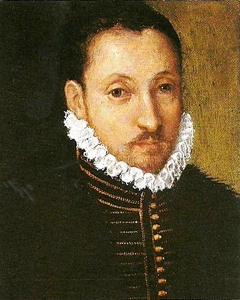
10 Razones Por las Cuales el “Matrimonio” Homosexual es Dañino y tiene que Ser Desaprobado
With Don Ferrante away at war, his mother, Donna Marta, directed his upbringing; and the piety and love of God that lay inside the holy youth rose to the surface. Donna Marta had consecrated the boy to God under the patronage of the Blessed Virgin. When the lord of Castiglione heard about it, he had Pope Gregory XIII annul the vow. He expected his son to inherit his rank and estates, develop military prowess and govern the Gonzaga dominions. But Aloysius decided even as a child that he would honor his mother’s vow.
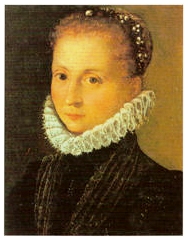
At the age of seven, he began to pray the Little Office of Our Lady and soon added the Rosary and other devotions and austerities. In order to prepare him for his future duties, Don Ferrante left him and his younger brother in Florence at the court of the Grand Duke of Tuscany (Francesco de Medici) for two years. Fortunately, the boys were assigned to a separate house with a tutor and priest in residence. One day while studying the mysteries of the Rosary, he became so inflamed with a burning love of Our Lady that he consecrated himself to her by an irrevocable vow of chastity. Henceforth, he refused to look upon the face of a woman; and the Mother of God rewarded him with a special grace by preserving him from any temptation against the virtue of purity.
Eternal and Natural Law: The Foundation of Morals and Law
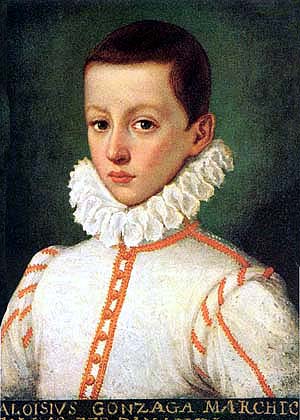
To complete their early education, the boys moved on to the palace of their cousin, the Duke of Mantua. A few weeks after arrival, the innocent youth came down with a serious malady for which the physicians prescribed strict abstinence in his diet. Once the illness had passed and the prohibition lifted, the youthful penitent still maintained the strict fast as a special devotion. At the age of twelve, he, along with his brother Ridolpho, returned to their family palace of Castiglione and he began his practice of finding some isolated room to spend long hours in prayer and divine contemplation.
During that summer, the great Cardinal Charles Borromeo made an apostolic visit to their diocese. He preached to a huge crowd in the cathedral among whom, in their reserved places sat Donna Marta and her thoroughly impressed son. The holy adolescent may have developed a meek and retiring nature, but interiorly he possessed abundant resourcefulness and courage, for he managed to obtain a private audience with the busy archbishop. Each saint instinctively recognized the sanctity in the other. When Saint Charles discovered that such a high degree of perfection had been reached by one who had as yet not received the Blessed Sacrament, he declared that he would administer it himself. And so the boy-saint received his First Holy Communion from the hands of the glorious Saint Charles.
Science Confirms: Angels Took the House of Our Lady of Nazareth to Loreto
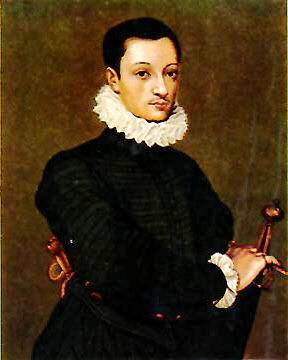
In 1581 Philip II summoned Don Ferrante to his court in Madrid to resume his office of chamberlain and his sons to act as pages for his oldest son, Don Diego. Here the struggle for the boy’s future vocation began, for Aloysius abandoned the use of jewelry and rich, colorful clothing and spent his free time in the city with the Jesuits, all of which displeased his father. Finally, Donna Marta revealed to her husband that her son wanted to become a Jesuit priest and resigned herself to a barrage of unjust anger. A few days later, Aloysius sought an interview with his father, with the same distressful results. The Marquis then called upon his cousin, a high-ranking churchman and eventual Cardinal, to examine the boy; he reported the latter definitely had a vocation and that it was God’s calling. Over the next few years the discussions continued, but in the end the maturity of the young saint’s intellect and his quiet inner resolve conquered the proud, imperious disposition of the Marquis.
The determined young man finally entered the novitiate in Rome in November 1585, but he was not destined to reach ordination. When a plague broke out five years later, he volunteered to care for the victims in a hospital by changing their clothes, making the beds and performing other loathsome tasks. His saintly life of devotion to the passion of Christ and His Blessed Mother, his patroness, came to an untimely but glorious end when he himself succumbed to the disease and died. Saint Aloysius’ confessor for his last months, the famous Saint Robert Bellarmine reported after his death that the holy youth never committed a mortal sin.
(Taken from Crusade Magazine, Vol.78, November-December, 2005, pp. 21-22.)

